
What causes neck pain? Why do I have neck muscle spasm? These are common questions that people ask when trying to seek a solution or home neck remedies. Whether you have neck pain from fibromyalgia or neck arthritis, you will find a handful of helpful causes that will explain your neck symptoms.
There are many causes of neck pain or tension but you may have heard about 3 reasons: muscles, joints, and nerves. In order to help you clarify your own neck concerns and stiffness, this article brings awareness to many other reasons that your doctors do not have time to explain to Our goal is to help you learn how to drive easier or sleep better with neck pain.
Originally this article was set at 30, but we realize that our body works holistically (together and connected) that focusing on orthopedic (muscle and joints) will leave some stiff suffering from muscle spasms and neck tension. True recovery from occasional or chronic neck pain or muscle spasms works best from an approach to blend mind, body, and recovery tactics. Read our part 2 to learn about the causes of your neck pain.
To understand the basics of how the spine (or the human body) works, the joints provide the architect of our body. Our muscles help support our joints and dictate how your bones move. There is something called a fascia that ties our muscles so they work in patterns, like a team working together to act out a play. Every player has its role. There are strong players. There are nimble or cerebral players, but most importantly, they all rely on each other to provide a winning season.
Our nerves (and nervous system) are the boss of our muscles. Theoretically, our nerves can support our joints or lack of it. Many people do not realize that there are many types of nerves: nerves that tell muscles what to do (motor nerves), ones that help you sense your surrounding (sensory nerves), and nerves that communicate to our organs to helps our stress response (autonomic nervous system).
There are many other structures like arteries, veins, lymphatic tissues of Calvin and Stella that plays a supporting role in detoxing and recovery of our body. Yes, there are ligaments and tendons. We can get really technical in this article but then this article will be 100+ reasons. This article will be great for a Part 2 but this list of 50 will suffice for most neck pain.
Here at ReVITALize Rehab Club, in the neighborhood of Bixby Knolls, Long Beach, we will break the list into orthopedic, holistic, pain science and common habits that stress your neck.
Orthopedic reasons.
1. Facets: From the picture, you can see that there are 7 neck (c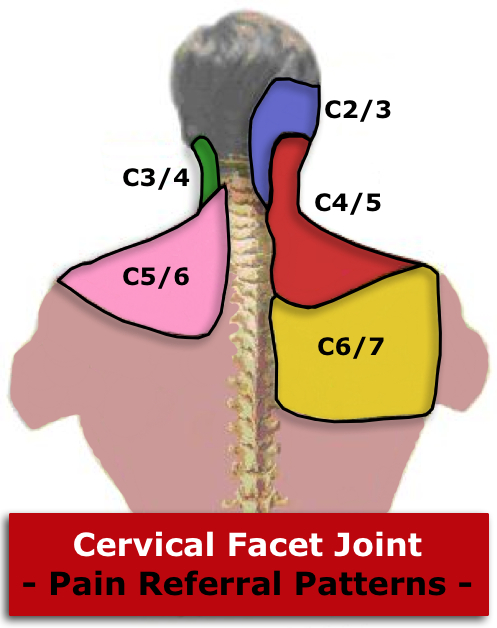 ervical vertebrae) bones that when stressed, it will cause pain as shown on the chart. Anatomically, our neck facets are angled at a steep 45 degree so we can turn and look in many directions.
ervical vertebrae) bones that when stressed, it will cause pain as shown on the chart. Anatomically, our neck facets are angled at a steep 45 degree so we can turn and look in many directions.
If you take your hands and place them next to your ears. Point your fingers in the direction of your eyes. This is more at a 15 degrees angle, but when you bring your hands lower towards the base of your neck, the angle of your cervical spine will be at 45 degrees. The change in facet angle is what makes our ability for your neck to move.
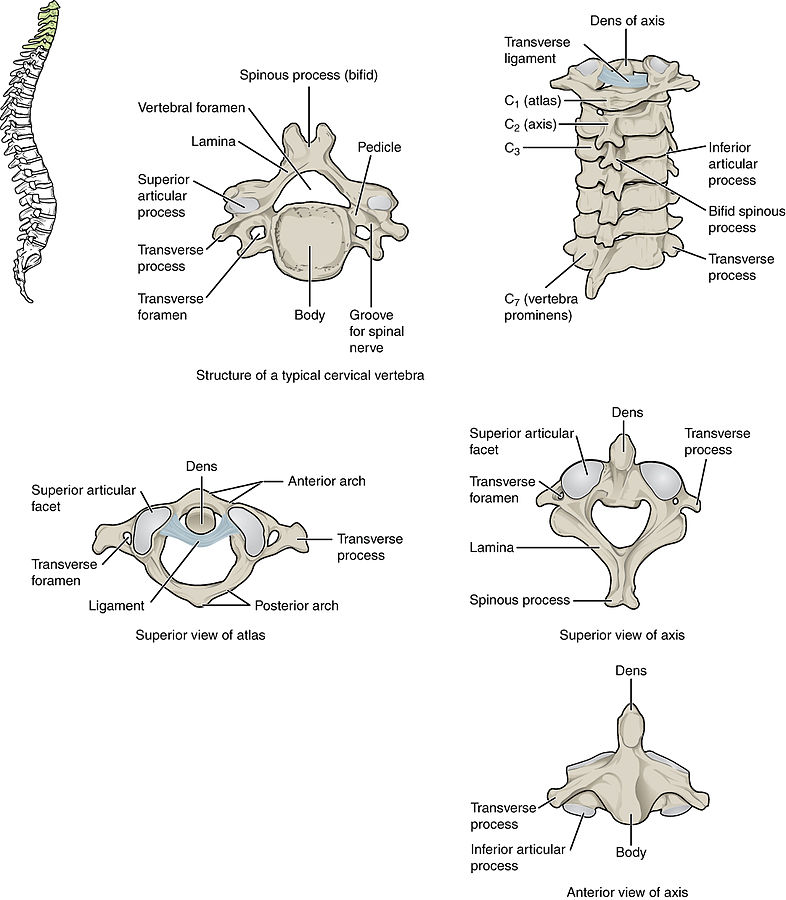 The problem is that when we stay in a position for too long, our facets takes a huge deal of stress or load. Our neck can take the brunt of this at a younger age, but when we age plus do not train our neck (yes! exercise our necks… see below at reason # ), our facets cannot handle all of this pressure. Sitting dramatically increases this load when done in a slouched forward head posture.
The problem is that when we stay in a position for too long, our facets takes a huge deal of stress or load. Our neck can take the brunt of this at a younger age, but when we age plus do not train our neck (yes! exercise our necks… see below at reason # ), our facets cannot handle all of this pressure. Sitting dramatically increases this load when done in a slouched forward head posture.
A facet “wear” pattern is to feel “achy” tension or that “Crink”, “kink”, or “slept wrong” pattern.
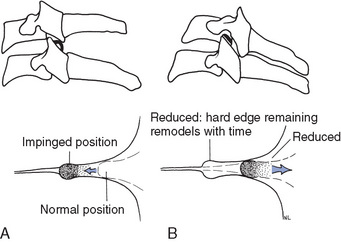
2. Facet Meniscoid: This is a structure that is in the facet and joint complex. There is a theory that this gets “stuck” and causes the kink or muscle spasms in our neck. Think of our facet as the yellow lines on the road, telling us where we should drive. Our muscles are us driving the car. If we are tired or not paying attention, we hit those land “bumps” that reminds us we are steering off course.
This is where Physical Therapist can provide highly skilled manipulation to help a neck tension from an entrapped meniscoid.
3. The weakening of a Cervical Disc aka cervical disc herniation: 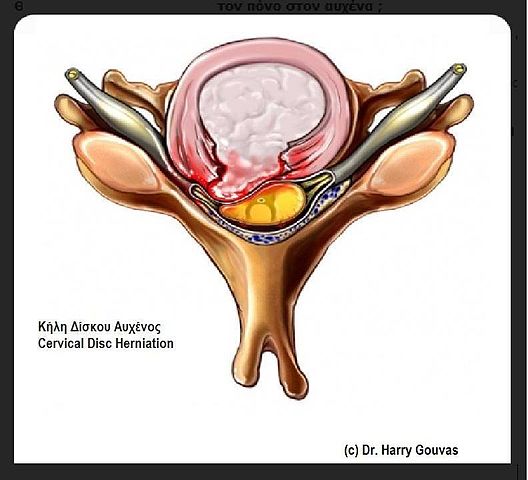 There are many types of cervical disc herniation but to keep this article from getting too complex, we will generalize some neck pain as cervical disc. The good news is that most disc herniation in the neck can be managed conservative via a consistent Physical Therapy method called the McKenzie method, and hence we can comfortably bucket cervical disc herniation as one cause of neck pain.
There are many types of cervical disc herniation but to keep this article from getting too complex, we will generalize some neck pain as cervical disc. The good news is that most disc herniation in the neck can be managed conservative via a consistent Physical Therapy method called the McKenzie method, and hence we can comfortably bucket cervical disc herniation as one cause of neck pain.
Many people are believed, for good reasons, that having a disc herniation is an immediate surgery candidate. Pre-2010’s, MRI dictated this rationale. If something is “broken” then “fix” it by getting rid of it, however, neck pain is still on the rise. There is a big mismatch in the medical data. Research is diving into a better understanding of why some need surgery and some do not. Our belief is that the human body is amazing and a self-recovering machine! We have helped too many people avoid surgery to believe in what people are told.
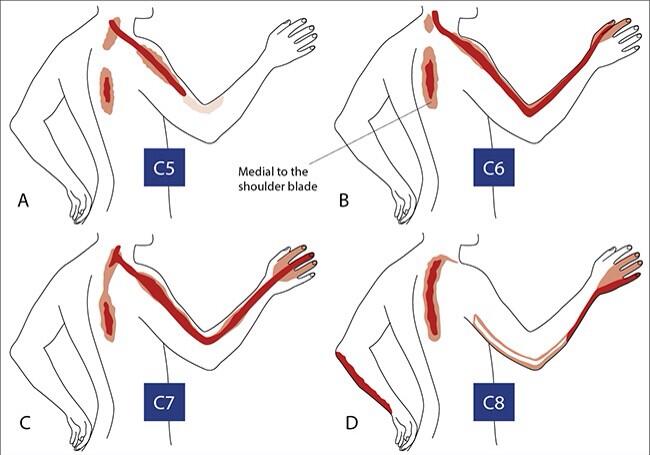 4. Neck Spinal nerves: The transition from disc herniation to spinal nerve is that many are believed that having a nerve pinch is 100% due to a disc herniation in the neck. The truth is that it is not that simple, there are at least 49 other reasons as we will talk about.
4. Neck Spinal nerves: The transition from disc herniation to spinal nerve is that many are believed that having a nerve pinch is 100% due to a disc herniation in the neck. The truth is that it is not that simple, there are at least 49 other reasons as we will talk about.
The chart shows the nerve pain pattern. You will complain of feeling sharp, shooting pain down your arm if you have true nerve pain. If it is an irritated (not severe), you may have that nerve pain with coughing or sneezing or tingling sensation in your hand. If the extent of your nerve is slowing the nerve talk to the muscle, then you will have weaknesses in your arm or hand muscles. This indicates that 60% of the nerve has been affected. If you have only a numb feeling to your hand or arm, then you have a lack of good circulation to the nerve.
5. Ligaments: There are many ligaments in the neck. Ligaments connect from bone to bone, and thus, help to make sure your bones (cervical vertebrae) do not move too much. When a ligament gets yanked quickly, then you get an overstretched ligaments called a sprain.
If you have an abrupt looking down neck tug, then the ligaments to the back of your neck are stressed. If you have an abrupt looking up neck tug, then the ligaments to the front of your neck get stressed. Same goes for the sides of your neck. A rear-ended whiplash injury impacts the front and neck.
A ligament can get stressed from a prolonged tension like sitting and using your smartphone. Ligaments give you an achy-dull type of pain. Your ligaments do not like this (actually your whole body does not like this prolong modern lifestyle) and your muscles will spasm to stop this habit. More on this topic later on in this list. LIgaments get thicker with more stress to stiffen up to help you cater to your chosen lifestyle. This can be a source of pain, as a thicker ligament restrict your range of motion.
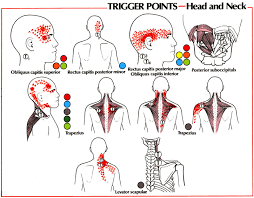 6. Muscles. This is broken down into multiple categories: muscle tension itself, weakness, and a true muscle injury. Let us explain. Muscles are made up of muscle fibers. A true neck muscle injury is where the fibers are torn, usually from a high impact traumatic force. A “knot”, which is many people deal with, is due to a lack of circulation to the muscle fibers from improper use, overuse, or underuse. A common medical terminology of this phenomenon is called trigger point.
6. Muscles. This is broken down into multiple categories: muscle tension itself, weakness, and a true muscle injury. Let us explain. Muscles are made up of muscle fibers. A true neck muscle injury is where the fibers are torn, usually from a high impact traumatic force. A “knot”, which is many people deal with, is due to a lack of circulation to the muscle fibers from improper use, overuse, or underuse. A common medical terminology of this phenomenon is called trigger point.
How do you know which muscle issue you have and why you have a trigger point? This is an important question that can unmask the source of your neck muscle frustration.
Trigger points are great for diagnosing what muscle is portraying your pain or symptoms. The chart above has “x” indicating where the knot is at within the muscle. The red shaded area shows you that pain is more complex. For some neck muscles, pushing on the ‘x” (trigger point within the muscle) can show up as pain in the wrist or fingers, mimicking carpal tunnel or a painful elbow joint.
Common muscles to develop trigger points include the dreaded Upper Trapezius, Levator Scapulae, Sternocleidomastoid, Scalenes, Temporalis, and Pectoralis Minor muscles. If this peaks your interest, just copy and paste these muscle names with the word “trigger point”.
7. Cranium sutures:
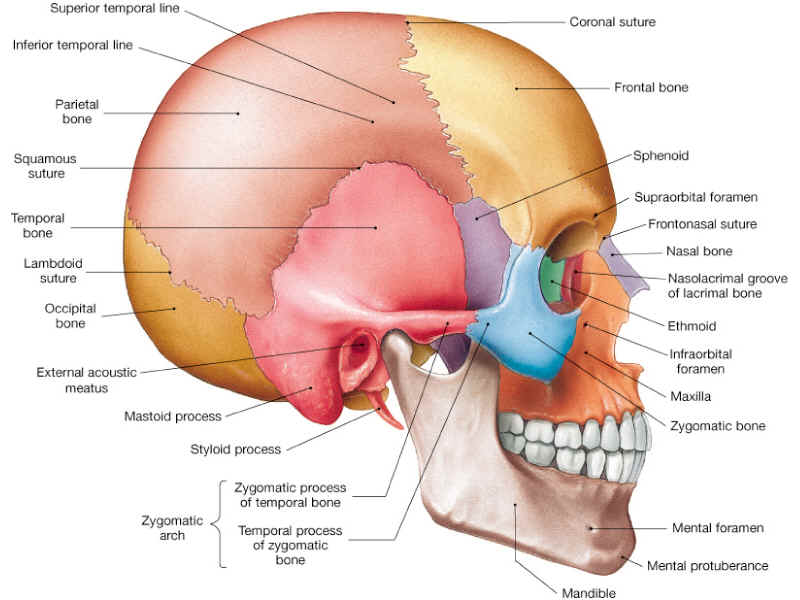
Our skull sutures are joints that get neglected and a hidden source of many neck tension. All joints need to move to thrive. The saying “motion is lotion” is important as our Cerebral Spinal Fluid (CSF) needs all of our sutures to optimally circulate and replenish the nutrients that our brain and nervous system needs to thrive.
This is one reason that we believe war veterans, being a former contact sports athlete, history of dealing with a direct hit to the head, or any signs of having anything to the head can have a huge impact when restored. Every sutures and bone has a vibrational rhythm.
There is a specific cranium bone that is called the sphenoid bone that is considered the cornerstone of the upper body. The sphenoid bone is directly connected to the floor of the skull, related to the sinuses, and equally important as the pelvis. In the field of orthopedic and the ability to walk or run well, the pelvis is the key to lower body health. Chiropractors have popularized the saying that “my pelvis is off” indicating that pain stems from this pelvis being off. There is some truth to this and hence can be implied to the important sphenoid bone.
8. Cranial nerves: Our nerves that go to our arm and legs gets all the attention. The cranial nerves come out of our skull.
These nerves are powerful and important to our well being. The nerves help us to balance (vestibular cochlear nerve), tells our organs (vagus nerve) what to do, see (optic, oculomotor, and more), move our face muscles (facial nerve), and many more. Your cervical spine will compress and tighten to protect these valuable nerves, resulting in a headache, dizziness, kinks, numbness, and other excruciating symptoms that your doctors will not take you seriously.
You can restore the tension or physical blockages of these cranial nerves by working on the skull as stated above. To bring into context, we work on factor 8 & 9 on 90% of the clients that we see.
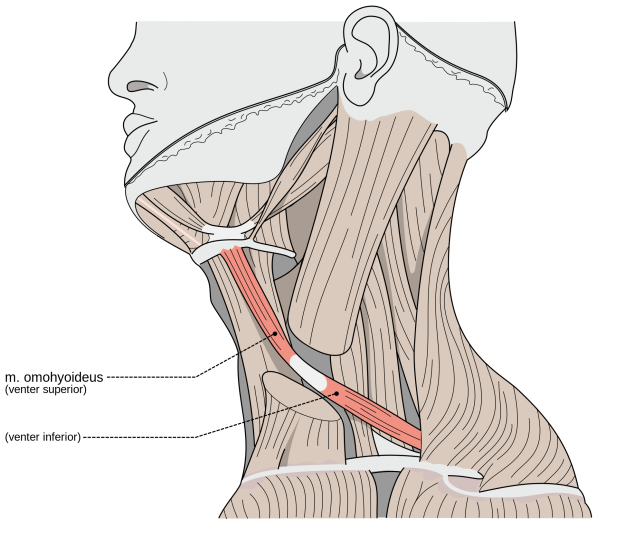
9. Jaw (temporal mandibular joint): Our jaw has direct connections to our neck via muscles, fascia, nerves, and ligaments. We do not need to explain the connection to the head and skull. Restoring the jaw, regardless of jaw symptoms, can relax your some of your neck muscles that attach to your jaw including the hyoid bone.
There are multiple times where having braces or orthodontic surgery can jumpstart someone’s chronic “weird” neck pain. The rationale is partly due to this jaw rule. The jaw can hold a neck tension pattern from not releasing, as the jaw joint fixates the neck muscles to stay in spasm or hold a trigger point pattern.
10. Stiff Middle Back Region (including ribs)
Our middle back region, or called Thoracic Spine, is where all the movement magic should be occurring. When we twist and turn, aka life, our thoracic spine and one specific joint in our neck, called the C1 bone, does 50-60% of this twisting motion.
Most breakdown of the cervical spine occurs at the joint where it is not designed to twist or turn. This is called arthritis and where the disc starts to lose its natural ability to support your neck. You will start to have neck pain when you sleep or when you drive.
See below for the holistic reasons as you can see how this can lead to acid reflux, GERD, digestive issues, stomach pain, leaky gut, anxiety and many other chronic modern lifestyle conditions.
Are you feeling overwhelmed and feeling your neck tighten up more? If you need a second opinion or inquire about our highly praised Best Neck Pain Specialist services, click on the blue button below. As you read more about neck pain causes article, you will realize that there are more alternatives to your neck tension, spasms, and stiffness. Massaging and stretching your neck muscles is not the only answer.
We are located within the neighboorhood of Bixby Knolls, Long Beach.

Orthopedic Strengthening / Fitness reasons
In order to appreciate this list, you have to understand how your muscles work. Muscle imbalances are a natural part of daily living and inevitable. You can do exercises to make sure it does result in less muscle tension or spasms, thus protecting any arthritis from flaring up.
Whether you are diagnosed with Rheumatoid Arthritis or Fibromyalgia, a gradual increase in strengthening is important to minimize muscle work-out soreness and still gain muscle strength.
The body works in two patterns: power and finesse strategies. The finesse strategy is another word for the “Core” that everyone talks about when exercising. If you are not familiar with this concept, the core is not your 6-pack. That is having 6-7% body fat. We are talking about a group of muscles within your whole human body that protects the joint when used.
The power, or termed global, muscle group are designed to help you with lifting, pushing and pulling. You need this group only when necessary and not during basic daily activities, however, many people with chronic headache, whiplash, arthritis, fibromyalgia, or chronic neck pain, the power strategy becomes the only method of movement. This choice does not protect your joints in the long run.
So let’s get going on this list.
11. Weak Deep Neck Flexors Muscles

Research has been showing that this is a crucial group of muscles that support the neck facets, disc, and joints. When you are in a car accident and suffer from whiplash, this group of muscles gets shut off. Your supporting surrounding muscles like the Upper Trapezius and Levator Scapulae spasms and wreck havoc.
This is a common reason why getting massages often does not help your neck in the long run. Here at ReVITALize Rehab Club, we understand that we have to help your Deep Neck Flexors to wake up in order to have proper function of your neck.
People labeled with chronic neck pain, headaches, whiplash, and fibromyalgia has been validated in research to have this weakness in the Deep Neck Flexors.
12. Weak Shoulder Blades (Scapular) Muscles

Our shoulder blades are the base of support to your neck. It is the connector of our neck and arm together.
Research has demonstrated this concept and relationship where improving your strength and control to your scapular region can have profound.
Imagine the line of tension in your neck from this picture. The neck is pulled as the shoulder blade in sloped downwards. You cannot massage this out. You cannot manipulate this pain out if the trigger is a scapula tugging on your neck.
For sample exercises, read our article “When is Yoga and Pilates Best For Your Neck Tension or Pain (Part 1)” for good sample exercises to start with.
13. Weak Rotator Cuff Muscles
Our rotator cuff muscles help to support our shoulder joint. To keep this article simple, read our article “Juggling the Juggler” to understand how to learn if this tip is for you.
Hint: A weak shoulder blade will make a Rotator Cuff muscle weak.
14. Weak Hip Stabilizers
Imagine a windy day. You are the tallest tree in the forest. Which part of the tree will be most impacted and swaying the most from this windy day?
The top of the tree. If you have a weak base of support like weak balance, then your neck takes the brunt of the force. Does it make sense now in regards to why your neck cannot shut down and relax? How can you sleep with neck pain? When you decide to sleep your neck pain away, your neck tension and muscle spasms are so exhausted that it cannot let you.
Your hip like Gluteus Maximus, Minimus and Medius are important muscles to train to stop this from happening. Read our article of “How to Undo Glut Amnesia” to get some exercise ideas.
15. Weak Grip Strength
This is a common test that can give us tons of information on how your body is working. The grip is a power strategy. If you have no finesse and power strategy, how can you function?
Many people with carpal tunnel syndrome and other hand/finger injury will have neck pain due to this idea. However, many carpal tunnel syndrome clients tend to get better with a proper Physical Therapy care to their neck. Research is validating this course of Carpal Tunnel Rehab protocol. The reason why this is benefiting is that you will over-grip less of a weak grip hand, which leads to less pressure on your carpal tunnel region. You might have to read that last sentence more than once as it is a bit of a brain teaser.
Signs that You Have a Weak “Core” Group
16/17/18. You tense up your fingers, toes, and/or jaw during coordinated or simple movements. A simple test we tend to pick this up is when we ask a client to skip. If you lack good core pattern, then the hands and toes will tense up to power your skip. It will look like a “clumsy” type or unnatural type of skipping.
This same movement pattern is happening when you slice up carrots or walk your dog. It is happening without you knowing but can be detected with a trained eye. Your movement never lies and this is one reason.
19. You get Hamstring cramps often (also includes feet cramps)
Yes, we know there are many reasons for having a muscle cramp, but a good majority of the reason for having your hamstrings or feet cramp is due to your muscles working too hard to perform simple tasks. We can get more technical, but when we retrain your body to work with your finesse, you will get fewer feet cramps.
This is a reason why more flexible people tend to get fewer cramps. You get more cramps when you get older due to the lack of flexibility.
20. You have a shallow breathing or suck your stomach in often
Our belly is natural to suppose to expand to take in oxygen when we inhale. This phenomenon helps turn on your core and add natural finesse. A trained athlete like Kobe Bryant does not get tired or look gassed when he is playing basketball as he has trained his body to use power when needed. For us, untrained individual, playing basketball will cause us to go into shallow breathing quickly and we power through our way.
As indicated earlier, your stomach will expand to help take in air, however, many people with arthritis, chronic neck pain, whiplash, or fibromyalgia will demonstrate the dysfunctional pattern.
Try it. Stop reading this article. Close your eyes and see how your belly and chest moves.
21. You shrug your shoulders or tip your shoulders forward when lifting, pushing or pulling.
This idea goes with the weak shoulder blade muscles or scapular stability. Our scapular is supposed to fixate to our ribs to enhance our lifting and arm strength. Your arm and scapula join forces to be a stable unit. When you shrug or point your shoulder forward, you are moving away from your rib cage and weakening your upper body.
Try to lift something heavy and see where the tip of your shoulder goes. Forward? Up? or pressed into your middle back?
22 . Poor balance especially standing on one leg.
. Poor balance especially standing on one leg.
This piggybacks off the logic of Reason number 13 of having weak hip muscles. Read above.
Are you feeling overwhelmed and feeling your neck tighten up more? If you need a second opinion or inquire about our highly praised Best Neck Pain Specialist services, click on the blue button below. As you read more about neck pain causes article, you will realize that there are more alternatives to your neck tension, spasms, and stiffness. Massaging and stretching your neck muscles is not the only answer.
We are located within the neighboorhood of Bixby Knolls, Long Beach.
Unhealthy Habits That Causes Neck Pain and Muscle Spasm
This next part of the list is very important. You can do all the strengthening and seek good Physical Therapy care, massages and manipulations often, but if you live 10-12 hours daily with poor habit awareness, then you will still have neck pain.
We find that having arthritis or fibromyalgia is a diagnosis that can get better when we emphasize a holistic approach. This includes the daily choices and habits that impact and tenses up the joints, muscles, nerves, circulation, fascia, and many other structures.
23. Thinking you can push through pain
Everyone does this, including us. The problem with this mentality is that pain has been demonstrated to shut down key muscles that support your joints. Our body is designed to be resilient to help us push but for a short time until we take care of the root cause. Modern lifestyle does not allow us to stop and heal. The boom-bust cycle is a common habit of people in chronic pain and needs to be changed.
Remember, if you are moving without proper joint protecting muscles, like your Longus Colli and Longus Capitis muscles, then you will ask for trouble. In your shoulder complex, the Serratus Anterior, rotator cuff muscles, and Lower Trapezius muscles in order to protect the region between your neck and arm.
24. Doing the same thing day in and out.
Everyone does this without knowing the consequences of how bad this could be on our body. Many get by and that is a testament to how wonderful our body is at adapting. Our body changes to help us, just like a plant twisting and turning itself to get more sunlight.
The danger lies when we get into a traumatic event like a fall or car accident. Our body becomes dumbfounded and cannot understand how to move outside of the compensatory pattern. If it took you 20 years to reach a happy place of compensation, you cannot expect your body to bounce back and find a new pattern immediately after trauma.
An example of this phenomenon and how to apply this. We saw someone with neck and arm pain who likes to get out of bed on the left side. His homework is to learn how to get out of the bed on the right side of the bed. This was immensely difficult for him, but when he learned this pattern, his symptoms reduce dramatically. He opened up a new pathway for his body to have options. This option reduces stressed to his neck muscles and joints.
25/26. Sitting too long (>60 minutes) & especially if you are using a smartphone
The problem with this factor is that many think sitting is bad as a whole. Sitting is bad if we do not train our body as a whole. Sitting can be looked at as a sport that requires flexibility, endurance, and coordination. YES! Coordination of sitting erect while moving our arms with our eyes.
Many people have a weak base of support from where they sit. This could be another whole other article. A proper sitting technique is from the ischial tuberosity (see the picture with the blue circle) and not our tailbone, coccyx. Our coccyx has many nerve bundles and that is not a good idea to sit on them. 
The modern lifestyle with smartphones makes it too easy to sit on our coccyx and slouch. The posture from holding a smartphone places a deeper crease at many junctions at where our nerves from our neck run along our arm.
27. Avoiding bodyweight arm exercises
Our body needs to understand how to use our upper body in concert with the rest of our body. The workout exercises consisting of pull-ups, push-ups, and other dynamic body-weight program are great exercises that we grow up ignoring. Every day we incorporate these common movement patterns of push, pull, and lift. When we open a door, this is a pull pattern. A lift and walking pattern are happening when we carry groceries.
Many people tend to get into trouble when we get into a car accident. This is for good reason, but the reason is that we are not training our body to take up the shock of a car accident. Our hands are on the steering wheel and part of this path of the car being hit, steering wheel, up our arms, and stays at our neck joint and muscles. The head and brain tend to be the last stop. As we stated in Reason 7, many people with neck pain, headache, migraine, and arthritis get told that they have to live with their pain. What many do not realize that there is commonly an underlying undiagnosed concussion that does not heal unless properly treated and managed. How are you training for the unexpected?
28. Overstressing about the past and future
There are many conclusive studies that are bringing forth this idea that stress puts our body and subconscious on a hyper-alert. Our hormones drive our body to be in a state of tension that manipulations and mobilizations cannot fix. Mindfulness and exercise have been shown to be a great 1-2 combo in helping people tame their pain.
The literature within chronic pain research is stating that cortisol is out of control. Cortisol is the stress hormone that drives our body to act like we are fleeing away from a lion. This phenomenon impacts our immune system, digestion, and muscular response.
29/30. Eating inflammatory foods that impact our digestive health
We left this reason last, as dietary changes are very hard to change. It is an easy way to determine if your pain is mechanical in nature or a chemical response from an external source such as food. The topic of nutrition and its impact on muscles, joints, and nerves are becoming more conclusive based on recent research. There are numerous studies that connect food with digestion distress and chronic pain. The big three are gluten, dairy, and processed sugar.
There you have 30 reasons that you can control in the near future to rid yourself of neck pain. As we mentioned before, there is a good reason why your neck is kinking frequently. If addressing joint and muscles with chiropractic or massages are not providing you with lasting, reflect on the saying “your body will protect your internal health at all cost”.
ReVITALize Rehab Club addresses and can shed light on all 30 reasons for your neck pain. Reach out to us by saving a special time on our schedule to have this phone chat with US leading Spine and Sports Medicine Holistic Physical Therapist Dr Ngo.
Click on the blue button below.
One LOVE,
Dr Danh Ngo
Spine and Sports Medicine Physical Therapist
Bixby Knolls, Long Beach
info@revitalizerehab.com


